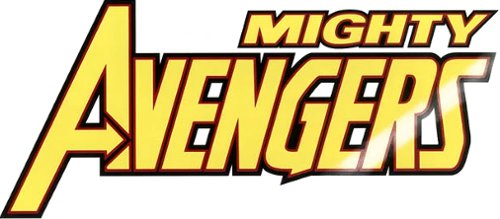Ant-Man: Season One – (2012)
Between 2011 & 2013, Marvel published almost a dozen “Season One” specials. These specials were out-of-continuity retelling of the character’s (or team’s) origin story in a 96+ page story. No doubt, these had been inspired by DC’s Superman: Earth One one-shot, which not only had sold 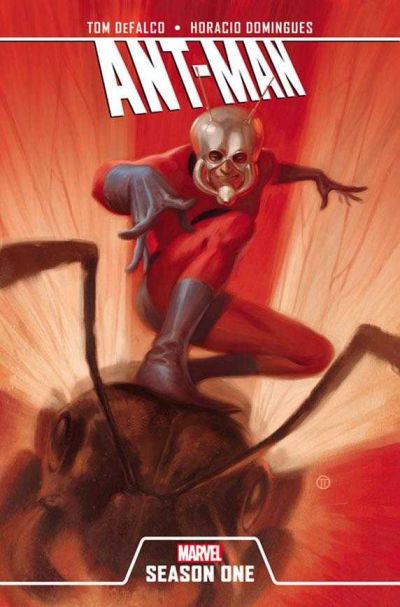 well in comic shops but were self-contained volumes that could be stocked in bookstores and serve as a fulfilling, complete tale for casual readers.
well in comic shops but were self-contained volumes that could be stocked in bookstores and serve as a fulfilling, complete tale for casual readers.
One of these Season One specials was for Ant-Man, specifically Hank Pym. Writer Tom DeFalco brought together aspects of Pym’s story which had originally unfolded over the course of years. In this tale, Hank Pym’s wife died in an apparent random terrorist bombing in Hungary, which led to mental anguish from which he was still recovering months later. Unlike the original storylines, Maria Trovaya had been a scientist in her own right and had been working on the method of communicating with ants, even as Pym had been working on his size-manipulation formula. Months after his wife’s death, Pym was pressured to return to work at Egghead Innovations by its owner, Elihas Starr (the true name of the villainous Egghead in the main continuity).
In his grief, Pym came to believe that Starr had been responsible for his wife’s death in order to steal both hers and his work. While the truth turned out to be more complicated, Pym did adopt the identity and costume of Ant-Man to expose Starr. A supporting character in the story was Bill Foster, known as Giant-Man & Black Goliath in the main line of comics. In the end, Starr was exposed as a criminal and Pym decided to continue in his quest for justice as the Ant-Man.
As these volumes were most likely intended to be timeless stories that future readers could pick up and read without needing to have read anything before or anything after to continue the story, it is unlikely that Marvel ever intended to publish a Season Two. Indeed, none of the original 11 volumes ever did.
| Writers | Artists |
|---|---|
|
|
Avengers: the Children’s Crusade – (2011-2012)
With Eric O’Grady gone as Ant-Man, it was time to bring Scott Lang back. After all, almost all of the characters that had died during Bendis’ 4-part Avengers Disassembled storyline had returned (Hawkeye, Jack of Hearts, Vision). Starting in 2010, Allan Heinberg’s 9-issue miniseries Avengers: the Children’s Crusade did just that, using the time traveling Young Avengers to whisk Scott Lang away moments before Jack of Heart’s explosion would have killed him. As joyous as it was for Cassie to be reunited with her living father, Scott’s world turned to tragedy when Cassie subsequently died in his arms, a victim of Doctor Doom’s carelessness.
| Writers | Artists |
|---|---|
|
|
FF (2nd series) – (2013-2014)
Following Jonathan Hickman’s Fantastic Four run, Marvel tapped Matt Fraction to take over Marvel’s “first family.” Fraction had a plan to follow two sets of FF teams separately, allowing him 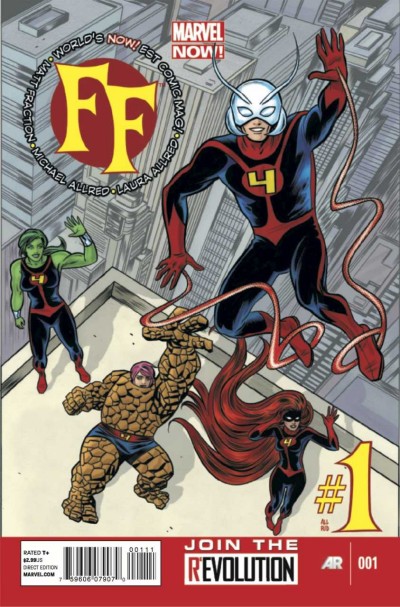 to write both the “core” FF team in one title and a “replacement” team (with which several previous writers had experimented) in another. The core Fantastic Four title (the fourth to bear that name) followed the core team as they took a family trip, exploring space and time in a repurposed alien ship. Although he intended only to be gone (comparatively speaking) for four minutes, Reed assembled a temporary Fantastic Four team as not to leave the Earth undefended. The name of this second title was simply named “FF” and among its cast was Scott Lang, the Ant-Man.
to write both the “core” FF team in one title and a “replacement” team (with which several previous writers had experimented) in another. The core Fantastic Four title (the fourth to bear that name) followed the core team as they took a family trip, exploring space and time in a repurposed alien ship. Although he intended only to be gone (comparatively speaking) for four minutes, Reed assembled a temporary Fantastic Four team as not to leave the Earth undefended. The name of this second title was simply named “FF” and among its cast was Scott Lang, the Ant-Man.
This was actually the second series to bear this name. During his own run with the Fantastic Four, Hickman had the team disbanded and replaced with a school/thinktank called the “Future Foundation.” To delineate this from the normal title, the Fantastic Four title was “canceled” and replaced by the title “FF.”
As with his first tenure with the Fantastic Four, Lang served as the resident scientist on the team, this one composed of She-Hulk, Medusa and a new character going by the name Ms. Thing. Along with the kids of the Future Foundation, this new FF faced several perennial foes and 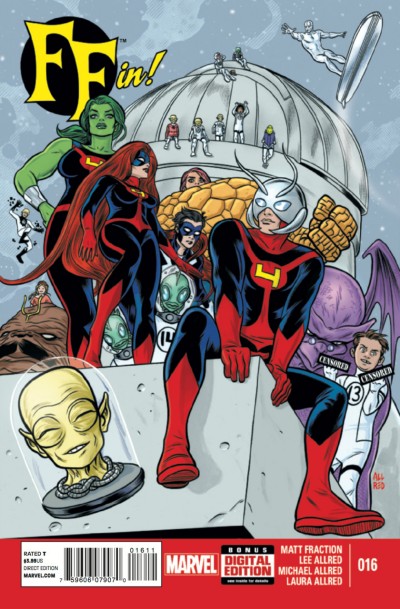 adversities, such as the Mole Man, the Frightful Four, Blastarr, the Impossible Man (and family), the Red Ghost & his apes and, of course, the Yancy Street Gang. However, most serious was Doctor Doom, who seemed to have teamed up with a version of Immortus called Kid Immortus, Annihilus and Kang’s future paramour, Ravonna. For Scott, coming into conflict with Doom was extremely personal, as he held the monarch reponsible for the death of his daughter, Cassie. This obsession would normally have easily spelled disaster for one with the power of an Ant-Man going against Doom and his armor. However, Scott Lang had a secret – a realization about the Pym particles that neither their discoverer, Hank Pym, nor even Reed Richards had considered. While the particles had previously shown uses of size and durability, in truth there was a third aspect (or “axis”) of strength. Using these three aspects in conjunction, Ant-Man was able to utilize strength and invulnerability to defeat Doom.
adversities, such as the Mole Man, the Frightful Four, Blastarr, the Impossible Man (and family), the Red Ghost & his apes and, of course, the Yancy Street Gang. However, most serious was Doctor Doom, who seemed to have teamed up with a version of Immortus called Kid Immortus, Annihilus and Kang’s future paramour, Ravonna. For Scott, coming into conflict with Doom was extremely personal, as he held the monarch reponsible for the death of his daughter, Cassie. This obsession would normally have easily spelled disaster for one with the power of an Ant-Man going against Doom and his armor. However, Scott Lang had a secret – a realization about the Pym particles that neither their discoverer, Hank Pym, nor even Reed Richards had considered. While the particles had previously shown uses of size and durability, in truth there was a third aspect (or “axis”) of strength. Using these three aspects in conjunction, Ant-Man was able to utilize strength and invulnerability to defeat Doom.
As had become the norm by this time, Marvel series were no longer open-ended, but had a sense of expiration once a creative team had told their story. To that end, Matt Fraction had finished his story with this back-up FF with #16 of that series, ending it there. Fraction put the finishing touches to the whole arc with the return of the core team with Fantastic Four (4th series) #16.
| Writers | Artists |
|---|---|
|
|
Ant-Man (1st series) #1-5 – (2015)
By the beginning of 2015, “Phase Two” of the Marvel Cinematic Universe was drawing to a close and the final film in this cycle was to be Ant-Man, starring Paul Rudd. It is no doubt for this reason that Marvel decided to give the character his own series, but it was also clear that it could not feature the character with his status quo as it existed then. Almost certainly the changes that were to occur with the comic character in that series were the result of editorial wishing to bring him in line with his cinematic counterpart and this required a few drastic changes.
Nick Spencer was to write the new series (and the one that followed). First to change was Scott Lang’s personality. The version played by Paul Rudd in the film was more of a “lovable loser,” a 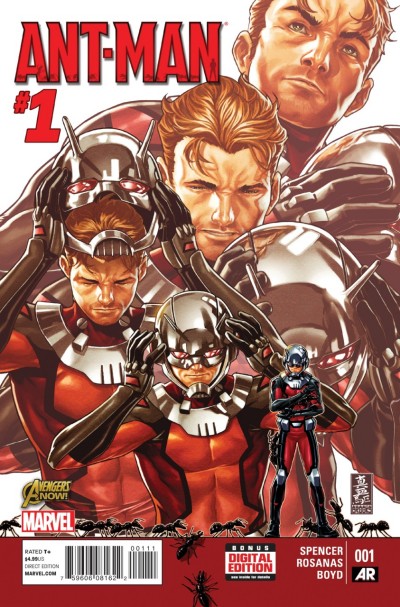 father who had trouble meeting his obligations, routinely letting down his family. As such, the self-confident (though never over-confident) Lang who had been an Avenger and twice worked with the Fantastic Four was given a more downtrodden personality and was always concerned how he never lived up to his promises. To this end, his tenures with (and departure from) the Avengers and FF were characterized as reflecting his lack of dependability. This led to his relationship with the super-hero community to be portrayed as estranged, something that had never been characterized before.
father who had trouble meeting his obligations, routinely letting down his family. As such, the self-confident (though never over-confident) Lang who had been an Avenger and twice worked with the Fantastic Four was given a more downtrodden personality and was always concerned how he never lived up to his promises. To this end, his tenures with (and departure from) the Avengers and FF were characterized as reflecting his lack of dependability. This led to his relationship with the super-hero community to be portrayed as estranged, something that had never been characterized before.
Aside from Lang’s personality, a change that needed to be made was his daughter, Cassie Lang, who had been dead since the Avengers: the Children’s Crusade miniseries. As Cassie was alive in the film, any potential new reader would be confused at finding her dead in the comics. This was easily remedied by Frank Barbiere, who was writing Avengers World at the time. Cassie’s return to life was explained as the actions of a morally-inverted Doctor Doom, who decided to make up for a past mistake by utilizing cosmic powers to resurrect her. Scott & Cassie’s reunion was depicted in the last two pages of Avengers World #15. However, in this new Ant-Man series, Cassie’s personality too was different. Aside from being seemingly de-aged from her depiction in Young Avengers, this resurrected Cassie never referenced her time as Stature or the Young Avengers in these first 5 issues and seemed uncomfortable with her father being Ant-Man and a superhero.
If these changes seemed to indicate that Nick Spencer did not care about continuity, every other aspect of the series made up for it. Villains and supporting characters included characters from Lang’s past and those of both Hank Pym and Eric O’Grady. Grizzly, who had worked with 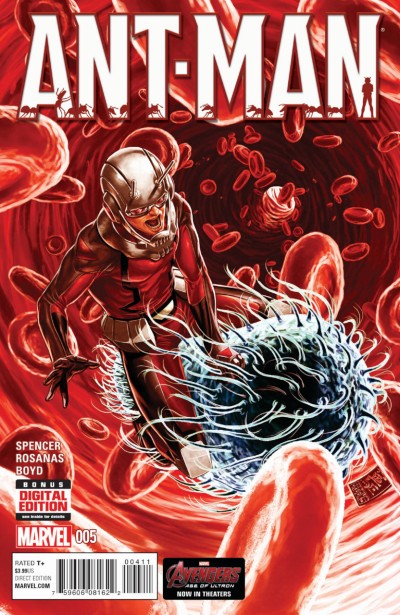 O’Grady’s Ant-Man during his time with the Thunderbolts, became a supporting character. Likewise, his first main villain was Taskmaster, against whom Lang had faced with Hawkeye years before. However, the main foe of the piece was industrialist Darren Cross, who had apparently been put in suspended animation following Lang’s confrontation with him in Lang’s first appearance. Although still alive, Cross had the same heart problem as before and this time kidnapped Cassie to obtain her heart, which due to its exposure to Pym particles had the ability to change sizes. Surprisingly, Cross succeeded in this plot and, even though she obtained a different heart to live, Nick Spencer used this as reason for Cassie to be denied access to size-changing Pym particles, explaining that they had been transferred to Darren Cross through the transplant.
O’Grady’s Ant-Man during his time with the Thunderbolts, became a supporting character. Likewise, his first main villain was Taskmaster, against whom Lang had faced with Hawkeye years before. However, the main foe of the piece was industrialist Darren Cross, who had apparently been put in suspended animation following Lang’s confrontation with him in Lang’s first appearance. Although still alive, Cross had the same heart problem as before and this time kidnapped Cassie to obtain her heart, which due to its exposure to Pym particles had the ability to change sizes. Surprisingly, Cross succeeded in this plot and, even though she obtained a different heart to live, Nick Spencer used this as reason for Cassie to be denied access to size-changing Pym particles, explaining that they had been transferred to Darren Cross through the transplant.
Although it is clear from the letters page that the series was set to be an ongoing, editorial seemed to want to retool the series a bit, so they ended it with an annual before moving on to the next. In Ant-Man Annual #1, Scott Lang teamed-up with Hank Pym (currently utilizing the Giant-Man name and costume) against Egghead, who like Darren Cross turned out not to be so very dead after all. The annual also introduced the character of Raz Malhotra, a tech genius who would go on to be the next Giant-Man. By the end of the story, the tale has caught up with Hank Pym’s apparent death in Uncanny Avengers (3rd series) and Lang discovered he had been in Pym's will, which left Lang Pym’s secret laboratory.
| Writers | Artists |
|---|---|
|
|
The Last Days of Ant-Man – (2015)
As early 2015 coincided with the impending release of the Ant-Man film, late 2015 coincided with Jonathan Hickman's Secret Wars miniseries, the culmination of his universes-ending “Incursion” storyline in New Avengers (3rd series). As a bridge between his first Ant-Man series and his next, the one-shot The Last Days of Ant-Man dealt with Scott Lang’s apparent “last adventure” as he became aware via the psychic former Miss Patriot that the universe was about to end.
Of course, although this did indeed turn out to be the case, the universe was restored at the end of the Secret Wars event into the “Eighth Cosmos” with the universe (more-or-less) none the wiser.
| Writers | Artists |
|---|---|
|
|
